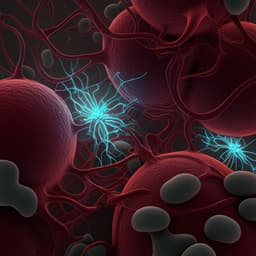
Food Science and Technology
Subcritical dimethyl ether extraction as a simple method to extract nutraceuticals from byproducts from rice bran oil manufacture
D. Wongwaiwech, M. Weerawatanakorn, et al.
This innovative study by Donporn Wongwaiwech, Monthana Weerawatanakorn, and Panatpong Boonnoun explores the remarkable ability of subcritical fluid extraction using dimethyl ether to effectively extract valuable nutraceuticals like γ-oryzanol, phytosterol, and policosanols from rice bran oil byproducts. The results highlight its potential as a leading green technology in the field!
~3 min • Beginner • English
Introduction
Byproducts from rice bran oil processing (defatted rice bran, rice bran wax, filter cake) contain high-value, fat-soluble nutraceuticals (γ-oryzanol, tocopherols/tocotrienols, phytosterols, and policosanols) with reported health benefits including antioxidant, anti-inflammatory, anticancer, and cholesterol-lowering effects. There is growing interest in green extraction technologies due to concerns about organic solvent residues and the costs and energy demands of supercritical fluid extraction (SFE). Subcritical fluid extraction (SUBFE) using dimethyl ether (DME) operates at low temperature and relatively low pressure and is considered an ecofriendly option. DME has favorable solvent properties for hydrophobic compounds and is recognized as a safe extraction solvent for food. However, prior to this work there were no reports using SUBFDME to extract γ-oryzanol, phytosterols, and policosanols from rice bran oil byproducts or to increase policosanol purity. The study investigates whether SUBFDME can efficiently recover γ-oryzanol and phytosterols from byproducts and, when combined with transesterification (TE), increase the purity of policosanols, providing a simple, low-pressure alternative for nutraceutical extraction and purification.
Literature Review
- Prior analyses showed rice bran oil byproducts contain substantial γ-oryzanol, tocopherols/tocotrienols, phytosterols, and long-chain alcohols, supporting their commercial potential as functional ingredients (Wongwaiwech et al., 2019).
- Supercritical CO2 extraction (SFE) has been widely applied to extract γ-oryzanol and phytosterols from various plant matrices but requires high pressures (100–690 bar) and investment.
- Subcritical fluid extraction (SUBFE) operates at lower pressure/temperature, reducing energy and cost; DME is a promising alternative solvent with low boiling point (−24.8 °C), saturated vapor pressure 0.51 MPa at 20 °C, low water solubility, strong affinity for hydrophobic compounds, and no solvent residue in extracts; EFSA has approved DME as a food extraction solvent.
- DME-based SUBFE has been applied to extract bioactives from algae and spices with effectiveness comparable to supercritical CO2 in some cases.
- Previous work largely optimized extraction conditions and yields, with little focus on purity of the target bioactives; no prior studies reported SUBFDME for γ-oryzanol, phytosterol, and policosanol recovery or for increasing policosanol purity from rice bran byproducts.
- Chemical transesterification has been reported to release policosanols from rice bran wax with notable yields in prior studies (approx. 21%).
Methodology
Materials: Industrial byproducts from rice bran oil manufacturing were obtained: defatted rice bran from solvent-extracted process (DFRB-S) and rice bran wax (RBW) from Surin Bran Oil Co., Ltd.; defatted rice bran from cold-pressed process (DFRB-C) and filter cake (FC) from Lopburi Vegetable Oil Industries. All defatted rice brans were dried (60 °C, 5 h), sieved (60-mesh), and stored at −20 °C. Analytical-grade solvents and standards for γ-oryzanol, phytosterols, and policosanols were sourced as specified.
Extraction approaches:
1) SUBFDME (subcritical dimethyl ether extraction): Lab-scale apparatus (10 g capacity) with reactor operated below 1 MPa. Samples loaded in cellulose thimble; liquefied DME introduced; reactor temperature, pressure (<1 MPa), extraction time (30 min), and stirring speed set; extract filtered (7 µm metal filter) and stored at −20 °C. Applied to DFRB-S, DFRB-C, and FC. RBW could not be directly processed by SUBFDME due to DME cooling causing wax solidification; hence RBW was first transesterified.
2) Transesterification (TE): Modified Aryusuk method. Samples dissolved in 2% NaOH in ethanol and stirred at 80 °C for 15 min; reacted mixture combined with warm isooctane and ethanol. The isooctane phase was separated and chilled (4 °C) overnight; crystallized wax filtered, washed with ethanol, dried (60 °C, 5 h), ground, and stored at −20 °C.
3) Increasing policosanol purity from TE-treated RBW and FC: TE-pretreated samples were further processed by SUBFDME under the same conditions to enrich policosanols. For comparison, solvent extraction (SE) with toluene was performed: the TE sample dissolved in toluene, shaken 30 min, centrifuged (4000 rpm, 10 °C, 15 min), supernatant evaporated to dryness; residues stored at −20 °C.
Analytical methods:
- Residual solvents in final policosanol extracts: Headspace GC–MS (Agilent 6890/7694, DB-5ms column) with SIM mode for isooctane, DME, ethanol, toluene, hexane, acetone, acetaldehyde. Headspace: 70 °C incubation 30 min; transfer line 150 °C; GC oven 35 °C (5 min) to 300 °C at 10 °C/min.
- γ-Oryzanol: LC–MS (Agilent 1100 with DAD at 298/325 nm; Zorbax Eclipse XDB-C18, 40 °C; ESI+ MS, m/z 200–800). Sample extracted with chloroform:methanol and mixed with acetonitrile:methanol:isopropanol before injection; external γ-oryzanol standard used.
- Phytosterols: GC–MS after saponification (60% KOH, 95% ethanol, 10% NaCl under N2), extraction with hexane:ethyl acetate (9:1), derivatization with BSTFA + 1% TMCS, SIM mode quantitation of campesterol, stigmasterol, β-sitosterol, sitostanol.
- Policosanols: Saponification with 0.2 M NaOH in methanol; extraction with toluene; filtration; GC–MS (DB-5ms, SIM) quantifying C22, C24, C26, C28, C30.
Statistics: ANOVA with Duncan’s test (SPSS 19), significance at p<0.05; results mean ± SD, dry weight basis, n=3.
Key Findings
- SUBFDME efficiently extracted γ-oryzanol and phytosterols from byproducts at low pressure (<1 MPa) and short time (30 min):
- γ-Oryzanol (mg/100 g, dry basis) by SUBFDME: DFRB-S 924.51; DFRB-C 737.46; FC 829.88.
- Phytosterols (total, mg/100 g) by SUBFDME: DFRB-S 257.12; DFRB-C 367.54 (highest); FC 312.34. Predominant sterols were stigmasterol and β-sitosterol across samples.
- Extraction yields:
- SUBFDME yields (%): DFRB-S 3.60±1.34; DFRB-C 9.71±3.03; FC 52.14±3.62.
- TE yields (%): FC 18.82±5.10; RBW 43.71±8.64.
- Policosanols (PCs):
- Direct SUBFDME on byproducts yielded low PCs (total mg/100 g): DFRB-S 51.88; DFRB-C 49.96; FC 58.48.
- TE greatly increased PCs, especially from RBW: FC 6100.12 mg/100 g; RBW 30,787.89 mg/100 g.
- Post-TE enrichment: SUBFDME on TE-FC and TE-RBW further increased PCs to 84,398.86±1,362.92 and 84,913.14±1,409.00 mg/100 g, respectively, corresponding to approximately 84% PC purity. SE (toluene) on TE samples yielded lower PCs: TE-FC 72,318.21±725.02; TE-RBW 62,717.72±546.46 mg/100 g.
- Extraction yields of crude PC concentrates from TE samples: SUBFDME (TE-RBW 2.49±0.49%; TE-FC 1.32±0.27%) vs SE (TE-RBW 18.24±0.56%; TE-FC 10.84±0.23%). Despite lower mass yield, SUBFDME provided higher PC purity/content.
- γ-Oryzanol and phytosterols in TE-enriched fractions: SE increased these in TE samples (e.g., γ-oryzanol in TE-FC 258.02 mg/100 g; TE-RBW 114.37 mg/100 g), whereas SUBFDME on TE samples showed ND for γ-oryzanol and lower phytosterols, consistent with preferential enrichment of PCs by SUBFDME.
- Residual solvents in final PC extracts were very low and below ICH limits: toluene 1.44 ppm; acetone 1.11 ppm; ethanol 1.06 ppm; hexane 0.93 ppm; acetaldehyde 0.81 ppm; isooctane 0.17 ppm.
Discussion
The findings demonstrate that SUBFDME is a highly effective, green, low-pressure method to extract γ-oryzanol and phytosterols directly from rice bran oil byproducts, outperforming conventional solvent extractions reported in literature in both yield and time efficiency. DME’s solvent strength for hydrophobics, low viscosity, and high diffusivity under subcritical conditions likely enhanced mass transfer and solute solubility, enabling high recoveries of γ-oryzanol and phytosterols.
For policosanols, chemical transesterification effectively liberates long-chain primary alcohols from wax matrices (especially RBW), but subsequent purification is crucial for high purity. Applying SUBFDME to TE-treated materials substantially increased PC content to about 84% of the extract, surpassing toluene SE in purity despite lower mass yield. Thus, a simple two-step workflow (TE followed by SUBFDME) is effective for extracting and purifying PCs from RBW and FC. In contrast, using SUBFDME directly on raw byproducts did not significantly concentrate PCs, indicating the necessity of TE pretreatment to cleave esterified waxes.
Collectively, the approach provides an efficient, solvent-minimizing alternative for nutraceutical recovery: direct SUBFDME for γ-oryzanol and phytosterols, and TE + SUBFDME for high-purity policosanols. The low residual solvent levels confirm suitability for food, supplement, and pharmaceutical applications.
Conclusion
SUBFDME is a novel, low-pressure and low-temperature green extraction technique that effectively extracts γ-oryzanol and phytosterols from rice bran oil byproducts. For policosanols, a simple two-step process—chemical transesterification followed by SUBFDME—achieves high purity (~84%) and higher PC content than traditional solvent purification, using shorter times and avoiding heavy solvent residues. These findings highlight a practical alternative for manufacturing dietary supplements, functional foods, and pharmaceutical ingredients from low-value byproducts (filter cake and rice bran wax). Future work could address process scale-up, continuous operation, optimization of DME recovery/recycling, economic assessments, and exploration of additional byproducts and cultivars, as well as profiling remaining minor constituents in the enriched PC fractions.
Limitations
- The SUBFDME apparatus was lab-scale (10 g capacity); scalability and continuous processing were not assessed.
- Rice bran wax could not be directly extracted by SUBFDME due to wax solidification from DME cooling; RBW required TE pretreatment.
- The study focused on selected nutraceuticals (γ-oryzanol, phytosterols, C22–C30 policosanols); other components (e.g., C32/C34 alcohols, vitamin E) were not comprehensively quantified in final products.
- Results may vary with rice cultivar and industrial processing conditions; only specific industrial sources were tested.
- Process economics and detailed energy/solvent recovery assessments were not included.
Related Publications
Explore these studies to deepen your understanding of the subject.







